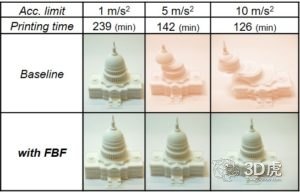Research breakthroughs at the University of Michigan's School of Engineering's Intelligent and Sustainable Automation Research Laboratory (S2A Labs) have made it easier for 3D printing enthusiasts to answer one of the most common questions in the industry, "How long does it take for 3D printing?" ". Before that, there is still no good short answer.
One of the main reasons for the slow speed of lightweight desktop 3D printers is that many parts vibrate throughout the process. When the printhead moves faster, more vibration is produced, eventually resulting in lower resolution parts. The S2A Labs team developed a filtered b-spline (FBS) algorithm to solve the speed problem.

Chinedum Okwudire, an associate professor of mechanical engineering at the University of Michigan's Intelligent and Sustainable Automation Research Laboratory, said: "After mastering the knowledge of the dynamic behavior of the printer, the program predicts when the printer may over-vibrate and adjust the printer's movements accordingly."
In order to achieve high quality printing, 3D printers need to operate at a speed that minimizes vibration. Often this leads the user to find the ideal speed through a series of print tests. The slow development of 3D printers is the main reason why some companies avoid using this technology in their operations.
Simon Shen, CEO of XYZPrinting, cited how printing speed limits industry growth:
Last year, Shen told Xiaobian, "We are just waiting for the next development of technology. If they can do it faster, more accurately, and easier, this will bring more people to adopt 3D printers. Don't wait for four to six. Hours, but wait for forty to sixty minutes. "To explain how the algorithm works, Okwudire likens it to someone who is trying to speak to a large audience. Without a loudspeaker, the speaker would have to shout loudly so that the person sitting in the farthest can hear the speech. If the speaker is holding a megaphone and continues to yell loudly, then their voice will become too loud and the audience will sound very erratic. However, if the speaker speaks at a normal volume through the loudspeaker, it will clearly resonate throughout the room.

"Our software is like the one who realizes that his voice will be over-amplified. It preempts people because it knows the behavior of the printer in advance," Okwudire said.
“Finally, one of the places we want to see the application of the algorithm is the firmware – the software that runs on the printer. This way, it will integrate with the printer regardless of its size.†The software might initially be on a lightweight desktop 3D Tested on the printer, but Okwudire said the software can be integrated into industrial grade printers, which are limited in speed due to vibration. The S2A laboratory compared the prints of the Capitol on the HICTOP Prusa i3 and produced comparative prints on the LulzBot TAZ 6.

The lab's findings were recently published by the Journal of Mechatronics. The study was led by doctoral students Deokkyun Yoon and Molong Duan.
This may be a major breakthrough in the 3D printing industry as it will make the final production of printed parts more viable. By increasing the speed and output quality of desktop 3D printers, they are more attractive to users who need high-resolution components, but don't have to pay thousands of dollars on industrial printers.
Babysitter High Chair,Baby Sitter Chair,Modern Baby High Chair,High Chair Baby Feeding
Zhejiang Lamon Technology Inc. , https://www.baby-chair.com